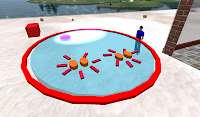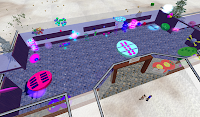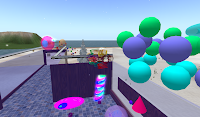 |
| The hall of small. The hall itself was designed and built by a student! |
There were tears along the way in this project. While some students settled happily into the world of possibilities in the edit panel and prim handles, others were overwhelmed and made careless mistakes, sometimes deleting their work without a clue how they had done so. You can bet that helped them slow down. They came out stronger for the experience. Just today a student jumped up and shouted out so happy she'd figured out how to successfully edit a script without my help.
It took me a while to figure out the exact workflow of this project, but I settled on 1) having them build in open space somewhere outside the exhibit hall, 2) teaching them how to link their prims and take them into their inventory, 3) rezzing their models in the exhibit hall and resizing them to an appropriate size (some started out huge!), 4) receiving a script from a script-giver I made (script me!) that makes hover text with or without rotation on touch (they edited the strings and hover text color) and putting that into their models, and, 5) adding an open URL button near their models that gives people more information about their topic.
That was all a lot to chew on for 7th graders. There were many steps to follow and I found it helpful to make printed tutorials for the major steps. I figured out a good solution for the script givers. At first they were running the scripts to be given when touched, which was confusing. I finally figured out I could uncheck run to stop them from running when they were given.



 |
| The students had to experiment. Their favorite shape seems to be the torus. |



2 comments :
oh very cool!!! i feel badly for those deleting their work and being clueless. i have been at that place many times and it feels so helpless. that's when someone needs a hug or pat the very most and to be told that it is all okay, just part of learning
i remember being so lost in math in the ninth grade, for something like three quarters of the year. i thought i would never, ever understand - i cried so much and felt so dumb
lol, i ended up with a minor in math in college!
very, very cool what you are doing with your students (it is amazing what happens when you let kids learn isn't it! they are wonderful) =)
Oh man, I dropped pre-calc when I tried it in college, and I'll bet some of the other students were as lost as I was but I just couldn't stand being left in the dark. Well I did not go on to minor in math :)
But I was so touched when a student posted this today about our science project. She is a quiet student and didn't say much through the whole project so her sincere comments were so touching:
"I loved this project! I enjoyed building and changing by enzyme to make it look how it is. It was fun to walk around in this amazing 3-D world of science and math on STEM island. Everything came alive. It was a little confusing and frustrating in the beginning. It took a lot of concentration and patience, but in the end it worked out very well. It was hard for me to follow the instructions on bringing my object into the showcase. That was the hardest part. It was also difficult to label my object correctly. I learning so much from this project, and I want to spend more time looking at other people's microscopic projects too. In this program it brought what is not normally seen, to be giant. This is a different kind of learning, and even though it is new to me I was taught beyond what i know. I thought the different phases of mitosis were a little confusing when I first learned it, but seeing what really happens helped. Next time you do this, students should work on it longer and have more choices of what to make.i think they should spend more time learning how to construct the microscopic models, but otherwise it was so fun!"
Seriously I believe if I didn't have students to do this for I wouldn't be doing it at all! They just make it all worth it.
Post a Comment